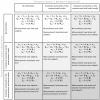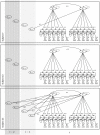Measurement invariance within and between individuals: a distinct problem in testing the equivalence of intra- and inter-individual model structures
- PMID: 25346701
- PMCID: PMC4193237
- DOI: 10.3389/fpsyg.2014.00883
Measurement invariance within and between individuals: a distinct problem in testing the equivalence of intra- and inter-individual model structures
Abstract
We address the question of equivalence between modeling results obtained on intra-individual and inter-individual levels of psychometric analysis. Our focus is on the concept of measurement invariance and the role it may play in this context. We discuss this in general against the background of the latent variable paradigm, complemented by an operational demonstration in terms of a linear state-space model, i.e., a time series model with latent variables. Implemented in a multiple-occasion and multiple-subject setting, the model simultaneously accounts for intra-individual and inter-individual differences. We consider the conditions-in terms of invariance constraints-under which modeling results are generalizable (a) over time within subjects, (b) over subjects within occasions, and (c) over time and subjects simultaneously thus implying an equivalence-relationship between both dimensions. Since we distinguish the measurement model from the structural model governing relations between the latent variables of interest, we decompose the invariance constraints into those that involve structural parameters and those that involve measurement parameters and relate to measurement invariance. Within the resulting taxonomy of models, we show that, under the condition of measurement invariance over time and subjects, there exists a form of structural equivalence between levels of analysis that is distinct from full structural equivalence, i.e., ergodicity. We demonstrate how measurement invariance between and within subjects can be tested in the context of high-frequency repeated measures in personality research. Finally, we relate problems of measurement variance to problems of non-ergodicity as currently discussed and approached in the literature.
Keywords: ergodicity; intra-individual level of analysis; latent variables; measurement invariance; state-space modeling.
Figures



References
-
- Akaike H. (1974). A new look at statistical model identification. IEEE Trans. Automat. Contr. 19, 716–723 10.1109/TAC.1974.1100705 - DOI
-
- Borkenau P., Ostendorf F. (1990). Comparing exploratory and confirmatory factor analysis: a study on the 5-factor model of personality. Pers. Individ. Dif. 11, 515–524 10.1016/0191-8869(90)90065-Y - DOI
-
- Borkenau P., Ostendorf F. (1998). The big five as states: How useful is the five factor model to describe inraindividual variations over time? J. Res. Pers. 32, 202–221 10.1006/jrpe.1997.2206 - DOI
-
- Borsboom D. (2008). Latent variable theory. Measurement 6, 25–53 10.1080/15366360802035497 - DOI
Grants and funding
LinkOut - more resources
Full Text Sources
Other Literature Sources

